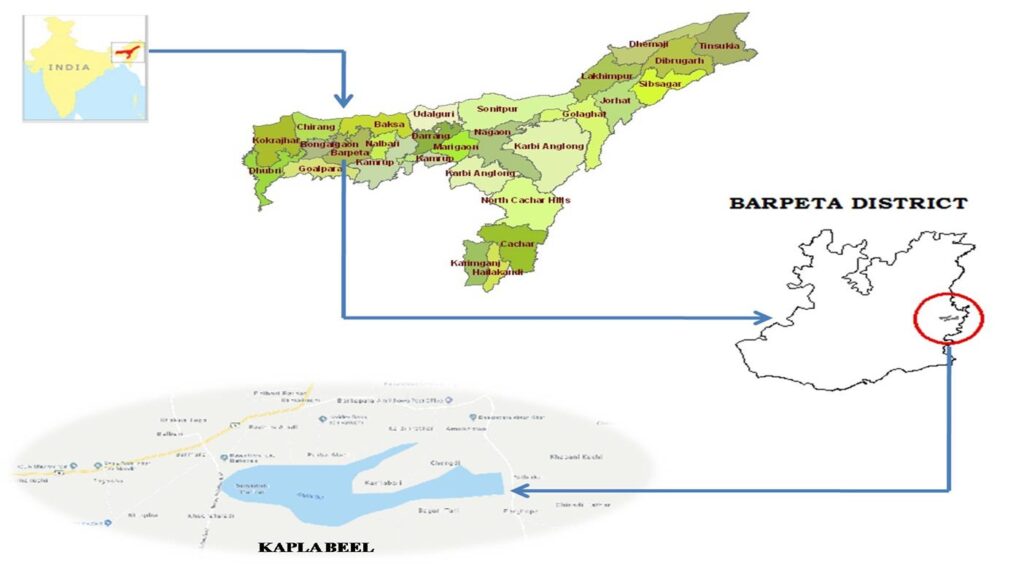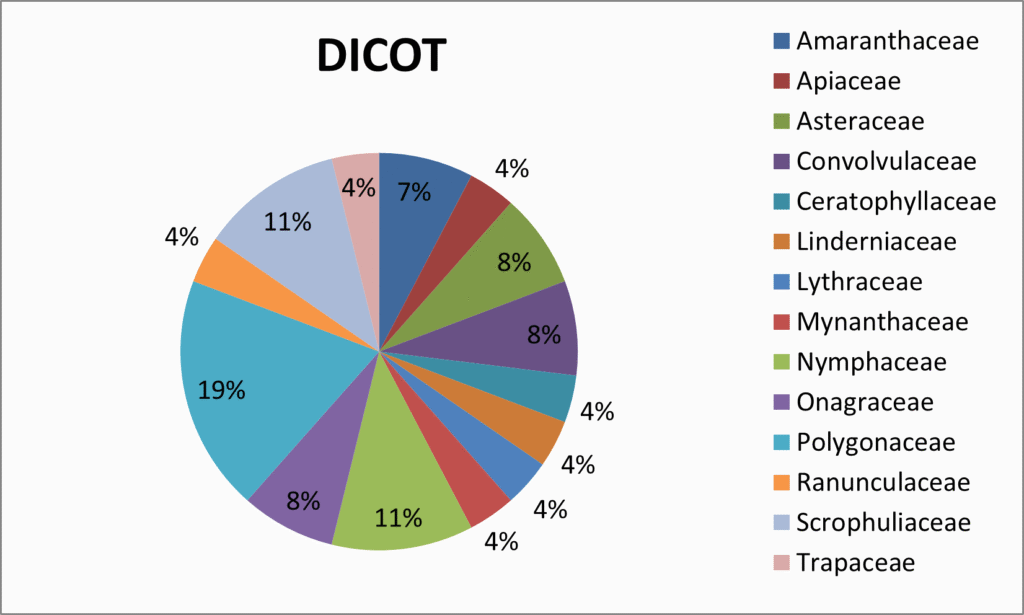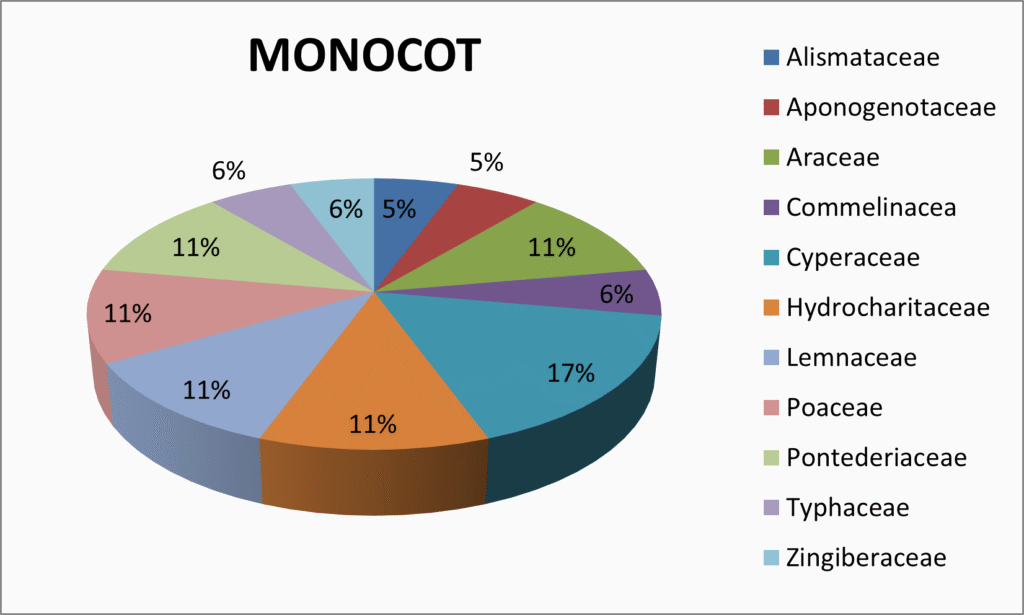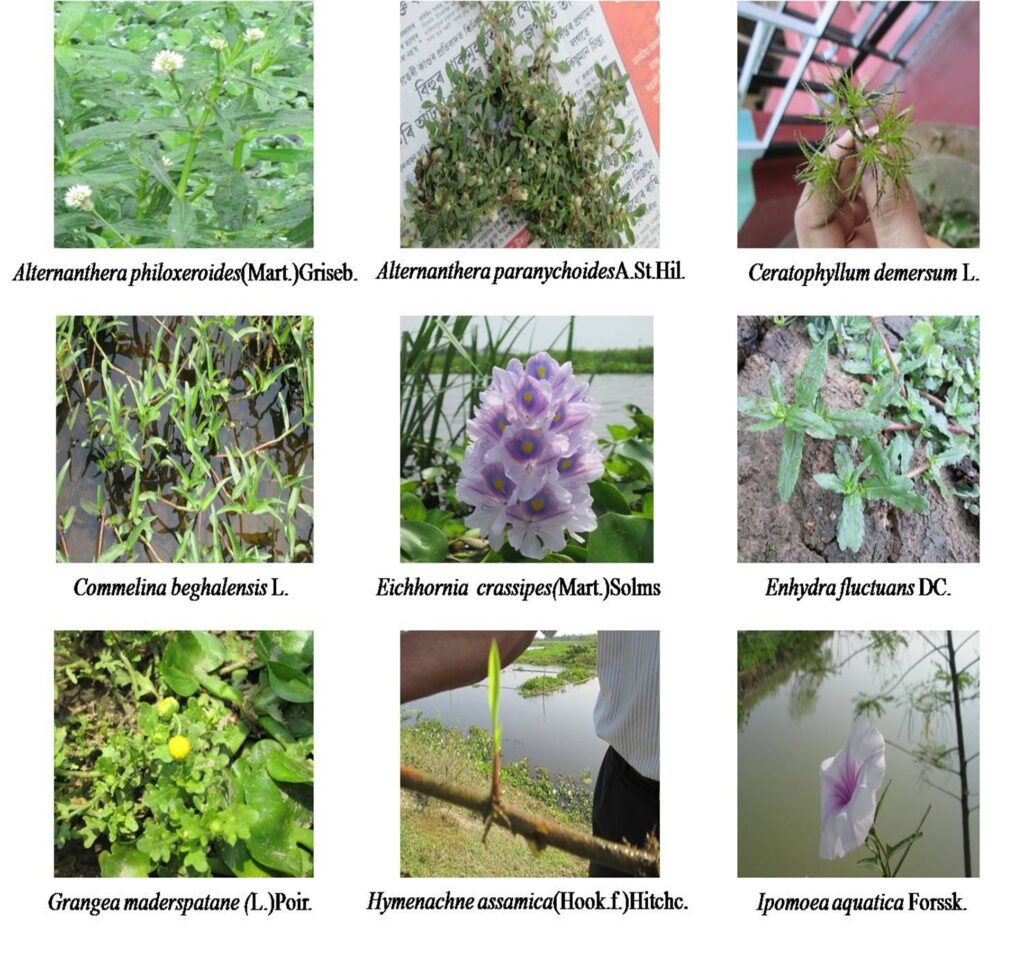Bhaskar Sarma1*, Nilakshi Kalita2
1Department of Botany, Dhemaji College, Dhemaji, Assam, India
2 Department of Botany, Gauhati University, Guwahati, Assam, India
*Author for correspondence: bhaskarsarma252@gmail.com
Abstract
Kapla beel is a wetland situated in Barpeta district of Assam, India. The wetland is rich in aquatic resources. A critical review of the literature indicates that there is little information about the floristic diversity of Kapla beel. Therefore the present study was undertaken to study the floristic diversity of Kapla beel. The beel is rich in both dicotyledonous and monocotyledonous plants. 14 families of dicot and 11 families of monocot were recorded during the field visit. There was less number of submerged and free-floating plants in comparison to marginal emergent and amphibians. Eichhornia cressipes are the most dominant species. Trapa natans are dominant during the monsoon period and Ceretophyllum is in the winter season. The majority of the species were found more or less throughout all seasons.
Keywords: Wetland; Kapla beel; floristic diversity; Eichhornia cressipes; Trapa natans; Ceretophyllum
Introduction
The term wetland refers to those areas that are transitional between dry terrestrial and permanent aquatic systems. Wetland has been defined differentially by different workers for different purposes depending on the objects and need. Generally, most of this definition is based on the topography, utilization, conservation, and management perspective of wetlands of a particular area or country. The globally accepted definition of the wetland was recommended in the Ramsar Conservation in Iran on Feb 2, 1971, which stated that “Wetlands are areas of marsh, fen, peatland or water, whether natural or artificial, permanent or temporary with water, the depth of which at low tide does not exceed six meters.” According to Cook (1996), “A wetland is a place where inundation must occur for at least 14 days and saturation for at least 60 consecutive days.” The wetland occupies only 6.4% of the earth’s surface (William,1990). Ramsar Conservation Bureau in 1997 recognized the wetland as an ecosystem that is very much important for biodiversity conservation.
Wetland plays an important role in the environment. These are considered the most biologically diverse of all ecosystems. The wetlands perform an abundant variety of functions. These are rich in biological diversity, highly diverse microbiological activity, a large genetic pool, and a link between transitional and aquatic ecosystems (Kulshretha, 2005). Wetland acts as a storehouse of many aquatic and semi-aquatic macrophytes and tree species of ecological and economic importance as well as a variety of amphibians, reptiles, fishes, etc.
Due to the extremely good natural environment and geography, India has about 4.1 million hector of freshwater wetland excluding paddy fields (Anonymous, 1990). Out of which 1.5 million hectares are natural and 2.6 million hectares are manmade (Hazarika and Barthakur, 2015). As the wetland of India is mostly situated at the floodplain major river, they are better designated as flood plains wetland (Sugunum, 1995).
The N.E region with its varied climatic condition supports the luxuriant growth of floristic elements and becomes a part of the India mega biodiversity hot spot (Sarma et al., 2018, Sarma et al., 2015, Sarma et al., 2016, Borthakur et al., 2018)
A critical review of literature of floristic studies of Assam indicates that there is little information about hydrophytic flora of Assam has been studied. However, works on certain areas in some districts of Assam have been published. Therefore the present study was aimed to study of aquatic flora of Kapla beel of Barpeta district of Assam.
Materials and Method
Study area
The Kapla Beel is a perennial freshwater wetland located at Sarthebari revenue circle of Barpeta District of Assam. It lies at the intersection of 26°15′-26°30’N latitude and 91°0′-91°15’E longitude, covering an area of about 91 hectares (Fig. 1). It is surrounded by five villages viz., Haldibari and Kaldipathar in East, Barkapla Gaon in West, Kamarpara Gaon in North, and Salmara Gaon in the South.

Fig. 1: Geographic location of Kapla beel
Data sampling
A field visit has been done in the year 2020. During this period, some of the important changes have been noticed. Throughout my study, I have found luxuriant growth of the Eichhornia sp. so that other many plants can’t grow there. The aquatic plant specimens were collected from various parts of the beel. Mostly the important parts of the plants such as the reproductive parts i.e the flowers and fruits were collected. The collected specimens were kept in plastic bags for making herbarium. They were also kept in bottles filled with 70% formaldehyde. Blotting paper and old newspapers were used for the preservation of the specimens. Regular changes of paper were done to prevent the breakage of the specimens. The fully dried specimens were mounted on the herbarium sheet. The unknown species were compared in the Gauhati University Herbarium house.
Results and Discussion
The greater Kapla beel or Wetland complex is the most biodiversity-rich wetland in the Barpeta District of Assam. The beel is very much blessed with the good potential of aquatic resources. An uneven distribution of useful wetland species by plant family has also been found elsewhere in the world (Jain et al., 2011; Naqinezhad et al., 2009; Rasingam, 2010; Saharia & Sarma, 2011). In the present study, I have found both Monocotyledonous and Dicotyledonous plants. Total 14 families from Dicots whereas 11 families from Monocots were recorded. We have recorded 25 species from different families of Dicotyledonous plants and 18 species from different families of Monocotyledonous plants (Table 1, Fig. 1, 2, 3, 4, and 5). From the study, it was seen that the aquatic angiosperms are growing both in and by side of the water bodies. However, the majority of the species are reported from the category of amphibians. There is a fewer number of submerged and free-floating plants in comparison to the marginal emergent and amphibians. However, Eichornia ,Nymphaea, Euryale, etc. show purely aquatic vegetation. From the study, it was noticed that the species abundance was reduced in the monsoon season due to the flood and water which causes the disturbance in their growth and development. Among the dominant species, Eichhornia cressipes is the most dominant species. Trapa natans were dominant during the monsoon period. Ceratophyllum is in the winter season. The study showed that the majority of the species were found more or less throughout all seasons.
Table 1: Name of plants recorded during the field visit
DICOTYLEDONS | |||
SL No | FAMILY | NAME OF THE PLANTS | |
1 | Ranunculaceae | Ranunculus sceleratus L. | |
2 | Nymphaeaceae | Nymphaea nouchali Burm.f. Nelumbo nucifera Gaertn. | |
3 | Amaranthaceae | Alternanthera philoxeroides (Mart.)Griseb. Alternanthera paranychoidesA.St.Hil | |
4 | Asteraceae | Enydra fluctuans DC. Grangea maderspatana(L.) Poir. Cotula hemisphaericaWall.ex Benth.& Hook.f. | |
5 | Apiaceae | Oenanthe sp. | |
6 | Convolvulaceae | Ipomoea aquatica Forssk. Ipomoea carnea Jacq. | |
7 | Scrophulariaceae | Limnophila heterophylla(Roxb).Benth. Limnophila indica(L.)Druce | |
8 | Lythraceae | Rotala rotundifolia (Buch.-Ham.exRoxb.)Koehne | |
9 | Menynthaceae | Nymphoides cristata (Roxb.) Kuntze | |
10 | Onagraceae | Ludwigia adscendens (L.) H. Hara Ludwigia octavalvis (Jacq.) P.H.Raven | |
11 | Linderniaceae | Lindernia anagallis (Burm.f.)Pennell | |
12 | Polygonaceae | Polygonum flaccidum L.flaccidum Polygonum flaccidum L. var. hydropiper Polygonum viscosum Buch.-Ham.ex D.Don Polygonum posumbu Buch.-Ham. ex D.Don Rumex maritimus L. | |
13 | Trapaceae | Trapa natans L. | |
14 | Ceratophyllaceae | Ceratophyllum demarsea L. | |
MONOCOTYLEDONS | |||
FAMILY | NAME OF THE PLANTS | ||
1 | Alismataceae | Sagittaria sagitifolia L. | |
2 | Hydrocharitaceae | Ottelia alismoides (L.)Pers. Hydrilla verticiliata(L.f.) Royle | |
3 | Lemnaceae | Lemna minor L. Spirodela pollyrhiza (L.)Schleid. | |
4 | Zingiberaceae | Alpinia nigra (Gaertn.)Burtt | |
5 | Cyperaceae | Cyperus compactus Retz. Cyperus rotundus L. Eragrostis uniloides (Retz.)Nees ex Steud. | |
6 | Araceae | Pistia stratiotes L. Colocasia esculanta(L.) Schott | |
7 | Pontederiaceae | Eichhornia crassipes(Mart.) Solms Monochoria hastata (L.) Solms. | |
8 | Poaceae | Hymenachne assamica (Hook.f.)Hitchc. Setaria glouca (L.)Beauv. | |
9 | Typhaceae | Typha | |
10 | Aponogetonacae | Aponogeton | |
11 | Commelinaceae | Commelina benghalensis L. | |

Fig. 2: Graphical representation of each family of dicot plant species occupied in the Kapla beel.

Fig. 3: Graphical representation of each family of monocot plant species occupied in the Kapla beel.

Fig. 4: Photos of some aquatic plants of Kapla beel
Conclusion
The wetland is full of aquatic flora as well as fauna. It has a great socio-economic value on the local inhabitants. The beel is mainly bounded by six villages viz., Kapla, Baniakuchi, Helaypara, Amrikhowa, Haldibari, and Churchuria. These villages having a population of approximately 14,100. Out of these, half of the population are dependent on the beel resources. The neighboring villagers used the beel land for agricultural practices. Some villagers engaged in cultivation in beel area. They used 12-27 hectares of land for the cultivation of paddy every year from December to April. In addition to fishery and agricultural resources, the local people collected certain species of aquatic plants viz., Trapa bispinosa, Nelumbo nucifera, Colocasia esculanta for various purposes. The Trapa is commonly known among the local people as “Singhori” from which a kind of fruit is obtained which has a greater commercial value. The flower of Nelumbo nucifera popularly known as “lotus” has been collected by local people for marketing. Again the grass plant of the beel Typha and Sparganium erectum is collected by locals for the use of fodder for live stocks. About 92-135 tonnes of grasses are collected by the villagers from the beel. The dependent people earn their livelihood from these resources which are obtained from the beel. However, the area of the beel is shrinking day by day because of various reasons which cause the gradual loss of aquatic flora and fauna of the beel.
Conflict of Interest
The author declare that there is no conflict of interest
Referrences:
- Anonymous (1990). Wetlands of India-A Directory, Ministry of Environment and Forest, Government of India, New Delhi, P 150.
- Borthakura, S. K., Baruah, P. S., Deka, K., Das, P., Sarma, B., Adhikari, D. & Tanti, B. (2018). Habitat distribution modelling for improving conservation status of Brucea mollis Wall. ex Kurz.–An endangered potential medicinal plant of Northeast India. Journal for Nature Conservation 43: 104–110.
- Cook, C. D. K. (1996). Aquatic and wetlands plants of India. Oxford University Press, New Delhi, India.
- Hazarika, S. and Barthakur, S. K. (2014). Hydrophytic flora of Assam II: Diversity of aquatic and wetland vascular plants of Nagaon district, Assam, India. Pleione 8(1): 96-108.
- Jain, A., Sundriyal, M., Roshnibala, S., Kotoky, R., Kanjilal, P. B., Singh, H. B. and Sundriyal, R. C. (2011). Dietary use and conservation concern of edible wetland plants at Indo-Burma hotspot: a case study from Northeast India. Journal of Ethnobiology and Ethnomedicine 7:29: 1 – 17.
- Kulasherestha, S. R. (2005). Conservation freshwater ecosystem in India. Environmental News. Inference Society of Environmental Botanists II (2):6-8.
- Naqinezhad, A., Jalili, A., Attar, F., Ghahreman, A., Wheeler, B. D., Hodgson, J. G., Shaw, S. C. and Maassoumi, A. (2009). Floristic characteristics of the wetland sites on dry southern slopes of the Alborz Mts., N. Iran: The role of altitude in floristic composition. Flora-Morphology, Distribution, Functional Ecology of Plants 204(4):254–269.
- Rasingam, L. (2010). Aquatic and wetland plants of little Andaman Island, India. Journal of Basic and Applied Biology 4(3):52–59.
- Saharia, S. and Sarma, C. M. (2011). Ethno-medicinal studies on indigenous wetland plants in the tea garden tribes of Darrang and Udalguri district, Assam, India. NeBIO 2:27–33.
- Sarma, B., Baruah, P. S. and Tanti, B. (2018). Habitat distribution modeling for reintroduction and conservation of Aristolochia indica L. – a threatened medicinal plant in Assam, India. Journal of Threatened Taxa 10 (11) : 12531-12537.
- Sarma, B., Basumatary, N. R., Nahar, S. and Tanti, B. (2016). Effect of drought stress on morphophysiological traits in some traditional rice cultivars of Kokrajhar district, Assam, India. Annals of Plant Sciences8: 1402-1408.
- Sarma, B. and Tanti, B. (2015). Karyomorphology of three species of Aristolochia – rare and endemic medicinal plants of Assam, India. International Journal of Cytology, Cytosystematics and Cytogenetics 68 (2): 154 – 158.
- Sugnum, V.V. (1995). Floodplain lakes- a fisheries persepective, In (ed.) Hows, J.R. Conservation and sustainable use of floodplain wetlands Asian wetland Bureaue, Kualalampur, pp-123.
- Williams, M. (1990). Wetlands: A Threatened landscape. Wiley – Blackweli. pp-
